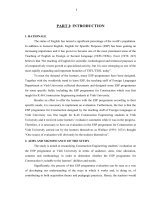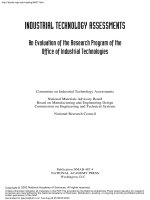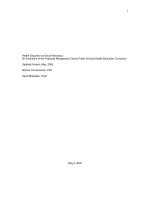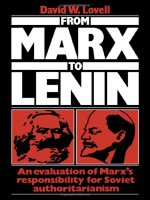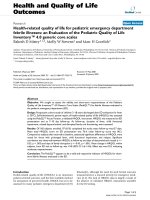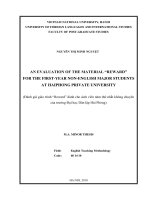An evaluation of the esp coursebook for second-year students at Marine Engine Department - Vietnam Maritime University (Vimaru)
Bạn đang xem bản rút gọn của tài liệu. Xem và tải ngay bản đầy đủ của tài liệu tại đây (876.19 KB, 70 trang )
VIETNAM NATIONAL UNIVERSITY, HANOI
UNIVERSITY OF LANGUAGES & INTERNATIONAL STUDIES
FACULTY OF POST – GRADUATE STUDIES
LƯƠNG THỊ MINH THU
AN EVALUATION OF THE ESP COURSEBOOK FOR
SECOND-YEAR STUDENTS AT MARINE ENGINE
DEPARTMENT-VIETNAM MARITIME UNIVERSITY (VIMARU)
(Đánh giá giáo trình tiếng Anh chuyên ngành dành cho sinh viên năm
thứ hai Khoa Máy Tàu Biển - Trường ĐH Hàng Hải Việt Nam)
M. A. MINOR THESIS
MAJOR : ELT METHODOLOGY
CODE
: 60 14 10
HANOI - 2012
VIETNAM NATIONAL UNIVERSITY, HANOI
UNIVERSITY OF LANGUAGES & INTERNATIONAL STUDIES
FACULTY OF POST – GRADUATE STUDIES
LƯƠNG THỊ MINH THU
AN EVALUATION OF THE ESP COURSEBOOK FOR
SECOND-YEAR STUDENTS AT MARINE ENGINE
DEPARTMENT-VIETNAM MARITIME UNIVERSITY (VIMARU)
(Đánh giá giáo trình tiếng Anh chuyên ngành dành cho sinh viên năm
thứ hai Khoa Máy Tàu Biển - Trường ĐH Hàng Hải Việt Nam)
M. A. MINOR THESIS
MAJOR
: ELT METHODOLOGY
SUPERVISOR: PROF. DR. HOÀNG VĂN VÂN
HANOI - 2012
TABLE OF CONTENTS
Declaration .................................................................................................... i
Acknowledgements ......................................................................................... ii
Abstract .......................................................................................................... iii
List of abbreviations ...................................................................................... iv
List of charts, figures and tables.................................................................... v
Table of contents ............................................................................................ vi
PART 1: INTRODUCTION
1.1.
Rationale ............................................................................................... 1
1.2.
Aims of the study .................................................................................. 2
1.3.
Research question .................................................................................. 2
1.4.
Scope of the study ................................................................................. 2
1.5.
Method of the study............................................................................... 3
1.6.
Design of the study ................................................................................ 3
PART 2: DEVELOPMENT
CHAPTER 1: LITERATURE REVIEW
1.1. Introduction ............................................................................................... 4
1.2. Textbook, course-book and material .......................................................... 4
1.2.1. Definitions.............................................................................................. 4
1.2.2. Roles of teaching materials in a language program ................................ 4
1.3. Course-book evaluation ............................................................................. 6
1.3.1. Definition of course-book evaluation ...................................................... 6
1.3.2. Why course-book evaluation ................................................................. 6
1.3.3. Types of course-book evaluation ............................................................ 7
1.3.4. Course-book evaluation in ESP .............................................................. 9
1.3.5. Why students’ evaluation ...................................................................... 10
iv
1.3.6. Techniques for course-book evaluation ................................................. 11
1.3.7. Models for evaluation ............................................................................. 12
1.3.8. Criteria for evaluation............................................................................. 14
1.4. Previous studies on materials evaluation.................................................... 14
1.5. Summary ................................................................................................... 16
CHAPTER 2: THE STUDY
2.1. Introduction ............................................................................................... 17
2.2. The context of the study ............................................................................ 17
2.2.1. An overview on Vietnam Maritime University and the Marine Engine
Department ..................................................................................................... 17
2.2.2. The course .............................................................................................. 16
2.2.3. The aims of the ESP course .................................................................... 18
2.2.4. The ESP course-book ............................................................................. 18
2.2.5. The ESP teachers .................................................................................... 19
2.2.6. The students ........................................................................................... 20
2.3. The study .................................................................................................. 21
2.3.1. Participants ............................................................................................. 21
2.3.2. Data collection instruments .................................................................... 21
2.3.2.1. Questionnaire ...................................................................................... 21
2.3.2.2. Interview ............................................................................................. 22
2.3.3. Procedure ............................................................................................... 22
2.4. Summary ................................................................................................... 22
CHAPTER 3: DATA ANALYSIS AND DISCUSSION
3.1. Results and discussion ............................................................................... 23
3.1.1. Learners’ attitude towards learning ESP ................................................. 23
v
3.1.2. Learners’ evaluation of the current ESP course-book ............................. 25
3.1.3. Learners’ evaluation of the teachers’ exploitation of ESP materials ........ 33
3.1.4. Students’ suggestions ............................................................................. 34
3.1.5. Teachers’ views of ESP course-book ...................................................... 36
3.2. Major findings ........................................................................................... 37
3.2.1. The suitability of the course-book to the audience .................................. 38
3.2.2. The suitability of the course-book to the aims ......................................... 38
3.2.3. The suitability of the course-book to the content requirements ............... 38
3.2.4. The suitability of the course-book to the methodology ........................... 39
3.3. Recommendations ..................................................................................... 41
3.3.1. Content improvements ............................................................................ 41
3.3.2. Layout improvements ............................................................................. 42
3.3.3. Methodology improvements ................................................................... 43
3.3.4. Other recommendations .......................................................................... 44
PART III: CONCLUSION
1. Summary of the study .................................................................................. 45
2. Limitations of the study ................................................................................ 47
3. Suggestions for further research ................................................................... 47
4. Conclusion ................................................................................................... 48
REFERENCE
APPENDIX 1 (Students questionnaire in English)
APPENDIX 2 (Students questionnaire in Vietnamese)
APPENDIX 3 (Teachers’ views as stated in the interview)
APPENDIX 4 (Checklist for evaluating ESP materials by Hutchinson and waters)
APPENDIX 5 (A sample of an original unit
vi
LIST OF ABBREVIATIONS
ESP: English for Specific Purposes
GE: General English
VIMARU: Vietnam Maritime University
1
LIST OF CHARTS, FUGURES, AND TABLES
Chart 1: Students’ levels of English
Chart 2: The aims of the material
Chart 3: The usefulness of tasks and exercises in skill development
Figure 1: Stages in the ESP process
Figure 2: The material evaluation process
Table 1: Students’ time of learning English
Table 2: Students’ ranking of their purposes of learning ESP
Table 3: Students’ needs met by the ESP course-book
Table 4: Students’ attitude towards the content of the ESP course-book
Table 5: Students’ attitude towards time allocation for ESP
Table 6: Students’ attitude towards vocabulary and grammar
Table 7: Students’ attitude towards language skills covered
Table 8: Students’ attitude towards tasks and exercises
Table 9: Students’ satisfaction towards classroom activities
Table 10: Students’ suggestions
Table 11: Students’ opinions towards teacher’s use of language and the course-book
Table 12: Teachers’ views of content
Table 13: Teachers’ perceived limitations of the course-book
Table 14: Students’ reactions to the course-book as observed by teachers
Table 15: Challenges to the students in using the course-book as observed by teachers
Table 16: Teachers’ self-reported challenges in using the course-book
2
PART I: INTRODUCTION
1.1. RATIONALE
It goes without saying that English is by far the most popular language of all.
Since Vietnam began its open-door policy, the English teaching and learning has
strongly developed. More and more people learn English in order to have a better work
opportunity. In Maritime field, English has been considered 'the language of the sea'.
This means English is the only language used by seafarers of all nationalities at sea and
this shows how important English is for seafarers.
Vietnam Maritime University (VIMARU) has been the leading university in
maritime section. After graduating from VIMARU, the students of Navigation
Department and students of Engine Department work not only on board domestic ships
but also on board foreign ships sailing around the world. Moreover, Vietnam is now a
member of WTO, Vietnamese seafarers will have golden opportunities to work on
European ships for higher payment if their English is good enough. Because of this, the
VIMARU leaders always consider English to be a very important subject.
A ship crew is divided into two departments: Deck department and Engine
department. When they work on a ship, it means that they live and work in an
international environment. English becomes their most important communication
instrument to carry out their daily communication. Especially, engine crews work in
the engine room and they need a good English for their marine engine major so that
they can operate all machinery on board well. In other words, ESP (English for
Specific Purposes) plays a fundamental role in the success of the marine-engine
students’ future occupation if they are to work on board the ship.
It can’t be denied that materials in general and ESP materials in particular play
an important role in the process of language teaching and learning as appropriate
materials can stimulate effective teaching and learning. Therefore, in order to have a
successful language- teaching program, it is necessary to have good materials,
3
especially in Vietnamese setting. The course-book “English for Marine Engine
Students and Ship‟s Engineers” was designed for the second-year students at Marine
Engine Department _VIMARU with the greatest effort of teachers of English
Department. This course-book has been used for nearly 15 years, however, no research
on the course-book evaluation has been carried out to see how much it meets the
students’ needs. For these above- mentioned reason, the researcher decided to choose
materials evaluation as the theme of this minor thesis titled as:
AN EVALUATION OF THE ESP COURSEBOOK FOR SECOND-YEAR
STUDENTS AT MARINE ENGINE DEPARTMENT_VIETNAM MARITIME
UNIVERSITY (VIMARU)
1.2. AIMS OF THE STUDY
The paper aims at evaluating the course-book English for Marine Engine
Students and Ship‟s Engineers to see how far it is suitable to the second-year students
at the Marine Engine Department, VIMARU. The specific aims are:
to evaluate the appropriateness of the material to the course requirements in
terms of aims, content, and methodology
to offer some suggestions for further improvement of the course-book which is
appropriate to the needs and expectations of the students
1.3. RESEARCH QUESTION
The following research question is raised for exploration:
To what extent does the ESP course-book English for Marine Engine Students
and Ship‟s Engineers at Marine Engine Department-VIMARU meet the course
requirements in terms of aims, content, and methodology?
1.4. SCOPE OF THE STUDY
The ESP course is only for the second year students at VIMARU, thus the study
focuses on the evaluation of the second year students at Marine Engine DepartmentVIMARU on ESP course-book currently used.
4
Hutchinson and Waters (1993) and many other language evaluation experts
agreed that evaluating a teaching material is a complicated process based on different
criteria such as audience, content, physical appearance, cultural bias, needs…..
However, because of the constraint of this kind of research, the researcher just focuses
on three criteria: aims, content, and methodology.
1.5. METHOD OF THE STUDY
The study follows a quantitative research approach. A Survey questionnaire is
designed for 162 second-year students at Marine Engine Department, VIMARU, who
have worked with two-thirds of the course-book to evaluate the quality of the ESP
course-book. In addition, interviews are conducted with three ESP teachers who have
been using the course-book to teach second-year students at VIMARU to gain
additional information about the quality of the course-book.
1.6. DESIGN OF THE STUDY
There are three main parts in this study: introduction, development, and conclusion.
The introduction provides the rationale, the aims, the research question, the scope,
and design of the thesis.
The development consists of three chapters:
-
Chapter 1, Literature Review, provides the relevant theories related to
textbook, course-book and material and course-book evaluation.
-
Chapter 2, Methodology, introduces the context of the study and describes
the methodology employed in the study, research procedures and the participants,
instruments and the research procedures.
-
Chapter 3, Data Analysis and Discussion, presents and discusses the findings
that arise from the data collected and recommendations
The conclusion provides a brief summary of all the contents studied, draws some
conclusions drawn and makes some suggestions for further research.
5
PART II: DEVELOPMENT
CHAPTER 1: LITERATURE REVIEW
1.1. INTRODUCTION
This chapter is concerned with the review of a theoretical base to develop a
framework in which the study operates. As a way of start, I will first explore the three
notions textbook, course-book and materials. Then, I will present an overview of
course-book evaluation including definitions; why course-book evaluation; types of
course-book evaluation; course-book evaluation in ESP; why students’ evaluation;
techniques, models and criteria for evaluation. Last but not least, previous studies on
materials evaluation are mentioned.
1.2 TEXTOOK, COURSE-BOOK AND MATERIALS
1.2.1. Definitions
McGrath (2002, p.7) defines a course-book as “a textbook on which a course is
based”. Tomlinson (1998: p.ix) shares similar point with McGrath when he considers a
course-book as “a textbook which provides the core materials for a course”. In his
viewpoint, a course-book is used to provide as much as possible in one book and it is
designed to serve as the only book which the learners necessarily use during a course.
In Materials Development in Language Teaching (Littlejohn, 1998) the term
“materials” is defined as “anything which is used to help to teach language learners. It
can be in the form of a textbook, a workbook, a cassette, a CD-Rom, a video, a
photocopied handout, a newspaper, a paragraph written on a whiteboard.”
(Tomlinson,1998: p.xi). Therefore, it can be pointed out that course-book is a type of
materials.
1.2.2. Roles of teaching material in a language program
The relationship between materials and other components in language teaching
such as students, teachers, teaching method and evaluation have been controversial for
6
many years. Since the end of 1970s, there has been a movement to make learners rather
than teachers the center of language learning. According to this teaching approach,
learners become the targets of teaching and learning process. Therefore, materials,
curriculum, teaching method and evaluation should be designed for learners and their
needs. For the teaching and learning English to be successful, besides teachers,
learners, curriculum, method and evaluation, materials play a decisive part in language
teaching and learning. The importance of teaching and learning materials cannot be
denied and so far, there have been a great number of discussions on different
perspectives on the role of materials in relation to other elements. Teaching materials
are considered the essential components in most language courses because they help
students and teachers know teaching and learning content. Discussing the importance
of English language teaching materials to learners, Allwright (1981) indicates that
materials help students know what to learn. In addition, he says, they are resources for
ideas, activities for instruction and they give teachers rationale for what to do. He also
emphasizes that materials control learning and teaching. It is undoubted that materials
are of importance in teachers’ language instruction. Both experienced and
inexperienced teachers rely on the materials. O’Neill (1982) supports Wright’s ideas
that materials help learning and teaching. It is true that in many cases, teachers and
students rely heavily on materials and materials determine the components and
methods of learning. They control the content, method and procedures of learning.
Students learn what is presented in the textbook and the way the textbook presents
materials in the way the teacher teaches it. Therefore, the materials become the center
of instruction and one of the most important influences on what goes on in the class.
Obviously, good teaching materials are of great help to both inexperienced and
experienced teachers, especially the inexperienced or poorly trained teachers because
they also provide models for teachers to follow in developing their own materials
7
(Nunan, 1998). Therefore, the first thing the teachers need to do when preparing his
course in his own situation is to select the appropriate materials.
In VIMARU, English for Marine Engine Students and Ship‟s Engineers was
designed by teachers of English Department. Due to the unavailability of various
resources, the material was compiled from various texts and most of the exercises were
designed by teachers. After being used for 15 years, it is necessary to evaluate the
material to see if it is appropriate or not.
1.3.
COURSEBOOK EVALUATION
1.3.1. Definition of course-book evaluation
Until now, there have been a number of materials evaluations of different author
in ELT. According to Tomlinson (1998: p.3), materials evaluation is defined as “a
systematic appraisal of the value of materials in relation to their objectives and to the
objectives of learners using them.” (Ellis, quoted in Figen, 2002, available at
./home/wwwsbe/thabs/2002/EDS.htm)
Hutchinson and Waters (1993: p96) also give definition of materials evaluation,
as “Evaluation is a matter of judging the fitness of something for a particular purposes.
Given a certain need, and in light of the resources available, which is out of a number
of possibilities can represent the best solution?” In other words, “Evaluation is
basically a matching process: matching needs to available solutions.”
In conclusion, from the general definition of evaluation and the definition of
specific area of materials evaluation, it can be inferred that materials evaluation
involve the determination of what needs to be evaluated, the objectives and
requirements of the materials, and the judgments of the value of the materials being
evaluated in relation to the objective and requirements determined.
1.3.2. Why course-book evaluation
Evaluation plays a very important role in the development of materials.
8
Robinson (1991) asserts the importance of evaluation as to provide the
advantages, disadvantages and the effectiveness of the being used materials so that the
material can be decided to be reused, adapted to meet the needs of the particular
teaching situation or changed.
Also, Ellis (1997) points out two reasons for materials evaluation. Firstly,
evaluation is carried out to choose among the available materials the most suitable one
to use for a particular situation and such valuation is taken before the course takes
place. Secondly, evaluation is carried out to determine whether the material which has
been chosen works for that situation after it has been used for a period of time. This
helps to decide whether to continue using the material or to replace it with a better
material.
In the words of Cunningsworth (1995: p. 7), course-book is “a resource in
achieving aims and objectives that have already been set in terms of learner needs”.
Through evaluation, we can assess whether the course-book is the most appropriate for
the target learners at various levels and in various teaching settings. What is more, the
evaluation process will involve elements of comparison, especially where existing
materials are being challenged by newly produced materials.
In summary, materials especially authentic materials play a significant role in
foreign language teaching. They are not simply the everyday tools of the language
teachers; they are an embodiment of the aims and methods of the particular
teaching/learning situation. Materials evaluation in general and course-book evaluation
in specific is very necessary and important. It may be taken for two reasons: first, it
confirms the course-book and second, it adjusts the course-book. Then, it will increase
the strengths and minimize the drawback of the course-book.
1.3.3. Types of course-book evaluation
There are many different ways of dividing course-book evaluation according to
different researchers.
9
According to some scholars, material evaluation in general and course-book
evaluation in specific are divided into three main types depending on the reasons for
evaluation, namely Preliminary, Formative and Summative.
The first type, Preliminary evaluation, is carried out by determining a set of
criteria which are used to reach a decision regarding which book to adopt and how it
needs to be adapted (Ellis cited in Tomlinson, 1998); thus, it is done before the
beginning of a course. The purposes of this type are to select “the most relevant and
appropriate materials for a particular group of learners”, and identify “specific aspects
of the published materials” needed adapting to suit the purposes of the evaluators.
(Ellis cited in Tomlinson, 1998: p.220)
The second type, Formative evaluation, is carried out during the course. This
type is aimed at shaping the material during its lifetime and suggesting the
improvement of the material in the future. (Dudley-Evans & St John, 1998)
The third one, Summative evaluation, is carried out at the end of the course.
According to Dudley-Evans & St John (1998: p.128), this type of evaluation is
obtained to “assess impact and to provide information that can be fed into repeat
versions” of the material. In addition, they believe that summative evaluation is
especially valuable for durable courses. Also, Richards (2001) claims that this type of
evaluation can determine the effectiveness of the material. Findings will help to decide
whether to use the material again or not; which tasks and activities are suitable and
which are not; which aspects of the materials need to be changed and how to modify
them to make the materials more effective and efficient for future use (Ellis, 1997). In
short, summative evaluation is carried out to determine the worth and value of teaching
materials after they have been used.
In addition, there is another way of dividing materials evaluation introduced by
Tomlinson (1998) and McGrath (2002). These authors identify three types of materials
evaluation namely Pre-use, Whilst-use and Post-use.
10
Tomlinson (1998: p.xi) who affirms that evaluation is “the systematic appraisal
of the value of materials in relation to their objectives and to the objectives of learners”
distinguishes three types of materials evaluations as follows:
-
Pre-use evaluation focuses on predictions of potential value.
-
Whilst-use evaluation focuses on awareness and description of what the
learners are actually doing whilst the materials are being used.
-
Post-use evaluation focuses on analysis of what happened as a result of using
the materials.
McGrath (2002) shares the similar point with Tomlinson when he introduces
three concepts: Pre-use, In-use and Post-use. From his opinion, McGrath (2002) claims
that these three types and their purposes are interrelated.
-
Pre-use evaluation establishes potential suitability.
-
In-use evaluation gathers data on planning decisions, implementation and
response; may stimulate preliminary reconsiderations of selection criteria.
-
Post-use evaluation uses data on in-course use and data on effects to access
suitability of selection and selection procedures.
In summary, although types of materials evaluation are indicated with different
terms, there is no difference in distinguishing evaluation process. Preliminary or preuse evaluation establishes potential suitability of the materials. Formative or in-use
evaluation examines how materials really work in by gathering data on planning
decisions, implementation and response. Summative or post-use evaluation is used at
the end of the course in order to provide retrospective assessment and identify which
strengths and weaknesses of the materials.
1.3.4. Course-book evaluation in ESP
To meet the needs of learners, many ESP course-books have been designed and
compiled for some specific fields. However, there can be a need for materials
11
evaluation to determine whether the material which has chosen works for that situation
after it has been used for a period of time (Ellis, 1997).
According to Hutchinson and Waters (1993), a careful course-book evaluation
in ESP can save a lot of expense and frustration. On the positive side, it can also help
in justifying requests to sponsors or other members of an ESP team for money to buy
materials or time to write them.
In ESP, evaluation in ESP has been viewed in the broad context of the teaching
and learning process. From the perspective of Dudley-Evans and St. John (1998),
evaluation does not stand alone, but occupies a prominent place in the ESP process,
giving an ESP teacher a wealth of information on their needs, expectations and
comments about the material (see Figure 1).
evaluation
need
analysis
assessment
course
design
teachinglearning
Figure 1: Stages in the ESP process
(Dudley-Evans and St. John, 1998: p. 121)
Obviously, materials evaluation is an indispensable part of the key stages in
ESP process (Dudley-Evans and St. John, 1998). In other words, course-book over a
period of being used needs to be evaluated to see whether it has worked well for the
target situations and students.
1.3.5. Why students’ evaluation
12
Together with the worldwide trend to learn ESP, many ESP course-books have
been designed for some specific fields. Course-book evaluation in ESP is an
indispensable part of the key stages in ESP process (Dudley-Evans and St. John, 1998),
and students’ evaluation is really necessary and important because of the following
reasons.
Firstly, in addition to teachers, students are the most important users of the
course-book. ESP course-book is designed to provide the learners with some basic
concepts and knowledge relevant to their field and skills up to the expectation of their
future employment. As a result, the students can give their own evaluative comments
on the course-book related to their own needs and expectation.
Secondly, being the people who use directly the course-book, the learners will
have information of the strengths and weaknesses of the course-book. Therefore, they
will give objective comments when they are not the course-book designers.
In short, it is necessary to have the course-book “English for Marine Engine
Students and ship‟s engineers” evaluated by the learners themselves at VIMARU to
see how far it meets the learners’ needs. Also, this evaluation is valuable for the
improvement of the course-book in the coming years.
1.3.6. Techniques of materials evaluation
There are three types of evaluation and each of them has their own method to
collect data (Robinson, 1991). The importance is that researchers should identify the
suitable methods in the study. A lot of technique used to evaluate materials attract
much attention and have been discussed by many researchers. According Hutchinson
& Waters (1993), Lynch (1996), Richards (2001), Robinson (1991), the useful
evaluation techniques are questionnaires, interviews, test results, discussion and other
informal means. The different methods used for evaluation have been mentioned but
they all have their possible advantages and limitations as follows:
13
Questionnaires are the most popular methods of data collection. They can be
used to elicit students’ and teachers’ comments on a wide range of issues. The
advantage is that they can be given to a large group of respondents at the same time
and they are not expensive (Wallace, 1998). However, questionnaires need to be
carefully designed to avoid respondents’ misinterpretation of questions.
Interviews, as Robinson (1991) stated, are also a valuable method for
evaluation. They have advantages of in-depth information on specific questions but the
problem is that it is very time-consuming though they can provide the opportunity for
more extended exploration of the issues than questionnaires.
Observation can focus on any observable aspect of the lesson and can provide
an objective eye to identify things that may not be very clear to the teacher. However,
it is a specialized work and requires careful preparation.
Document analysis refers to any documents that are involved in evocation, such
as: curriculum description, policy statement, newspapers, and program brochures,
correspondence and so on (Lynch, 1986).
To sum up, there has been a large number of different methods to collect data.
The researcher should identify what types of these instruments to be used effectively in
their study. According to Hutchinson & Water (1993) and Robinson (1991), employing
instruments in an evaluation project will depend on what suits the particular situation;
the combination of two methods including questionnaires and interviews is applied for
data collection in this study.
1.3.7. Models for evaluation
According to Hutchinson and Waters (1993), evaluation is a process of
matching needs to available solutions. The evaluation process is divided into four steps
14
as follows: Defining criteria; Subjective analysis; Objective analysis; Matching. The
above steps are presented in the following diagram as the following:
DEFINE CRITERIA
On what bases will you judge material?
Which criteria will be more important?
SUBJECTIVE ANALYSIS
What realizations of the criteria do
you want in your course?
OBJECTIVE ANALYSIS
How does the material being
evaluated realize the criteria?
MATCHING
How far does the material match your needs?
Figure 2: The material evaluation process( Hutchinson and Waters, 1993: p. 98)
In Hutchinson and Waters’ view, a teaching material in general and a coursebook in particular has to suit the needs of a number of parties such as teachers,
students, sponsors, so it is important that the subject factors should not be allowed to
obscure objectivity in the early stages of analysis. In order to have an objective
matching, it is advisable to look at the needs and solutions separately. However, in the
final analysis, any choice will be made on subjective ground.
In summary, Hutchinson and Waters (1993) suggest the model for material
evaluation that presents a logical procedure. This model also has a clear-cut description
of the stages and criteria, which are presented systematically. Besides, it can help the
researcher knows exactly what must be done to analyze the material in comparison
with the course requirements. Therefore, in order to determine whether the existing
material is suitable for marine-engine students at VIMARU, the evaluation framework
by Hutchinson and Waters (1993) has been chosen.
15
1.3.8. Criteria for evaluation
Various scholars have suggested different ways to help evaluators become more
systematic and objective in their method of evaluation by using a checklist.
Hutchinson and Waters (1993, p.99-104) suggest five evaluation criteria for
objective and subjective analysis as follows:
-
Audience: the learners and the materials intended for
-
Aims: the aims of the course and the aims of the materials
-
Content: language description, language points, proportion of work on each
macro-skill,
macro-skills, text-types, subject-matter areas, level of
knowledge, types of topics, treatment, organization of content within the
course units, sequence of content throughout the course, sequence of content
within a unit
-
Methodology: theory of learning, learners’ attitudes, kinds of exercises,
teaching-learning techniques, aids, guidance/ support for teaching, the
flexibility of materials
-
Other criteria: price, quantities, availability
In summary, choosing appropriate criteria plays a very important in evaluating
the suitability of the material in general and the course-book in particular to the
learner’s needs and expectations. Together with the evaluation model by Hutchinson
and Waters, the list of criteria for evaluation introduced by them appears to be more
suitable to the ESP course-book at VIMARU
1.4. PREVIOUS STUDIES ON MATERIALS EVALUATION
Evaluation is obviously a world-wide activity which has been more and more
appreciated by teachers and researchers. According to Brown (1989, p223), evaluation
is the systematic collection and analysis of all relevant information necessary to
promote the improvement of a curriculum and assess its effectiveness and efficiency.
Up to now, there have been many studies done in the field of evaluation of ESP
16
materials. Many of these studies have brought about good improvement for the
textbooks or teaching materials themselves and for ESP courses. We can count on
Figen (2002), Griffiths (1995), James (2002) or Nguyen Thi Thai Ha (2004,), Vo Thi
Anh Dao (2004), Tran Thi Thuy Nga (2005), Dong Thi Hien (2006) or Hoang Thi
Tham (2007). These evaluation had been done on different kinds of materials such as
ESP for engineering students, for Electronics and Telecommunications students, for
marine students, for information technology students or medical students. Vo Thi Anh
Dao (2004) made an evaluation on the ESP textbook used for the students of
Husbandry and Veterinary Science in 2000. Nguyen Thi Thai Ha (2004) evaluated the
ESP material used for freshman postgraduate students at Hanoi University of
Technology in 1999. Vu Thi Lua (2005) had a critical look at the ESP course book for
students of Business and Management at Hanoi UBM and then she made some
recommendations for a better use. Dong Thi Hien (2006) made an evaluation of ESP
materials used for the second year students of Security at People’s Security Academy.
All of these researchers of ESP materials aimed at finding out the strengths and the
weaknesses of the materials and then usually gave suggestions for improving the
materials. As this thesis aims at evaluating the ESP course-book for second-year
students at Marine Engine Department-VIMARU in terms of aims, content and
methodology, to determine whether it meets students’ needs and the aims of the course,
the researcher just want to review two Vietnamese studies that have the similar aspects
shall be reviewed in more detail.
Pham Thi Thu Huong (2006) carried out an evaluation of the ESP material
“English in medicine” for 3rd year students of medicine at the Military Academy of
Medicine (MAM) in terms of aims, content, methodology and to determine whether the
material is suitable to the students with regards to their level of English. The study
employed a combination of two data collection instruments, namely questionnaires and
interviews for teachers and students. Also a research on ESP material, Pham Thi Thanh
17
Huyen (2009) made an evaluation of the material for freshman postgraduate students of
General Medicine which has been used as the official course book for the ESP courses
at ThaiBinh medical university since 2003 to see if it met the students’ language levels,
the course’s aims, content and methodology. She also followed the model of material
evaluation proposed by Hutchinson and Waters (1993).
From the studies on the material evaluation presented above, it is founded that
the material evaluation model suggested by Hutchinson and Waters (1993) was
employed by most of researchers, especially the Vietnamese ones. This model seems to
fit their teaching and learning contexts. The data collection instruments including
questionnaires and interviews were the most popular. The review of the studies above
have prompted the researcher to use Hutchinson and Waters (1993)’s model to carry
out the material evaluation at Marine Engine Department-VIMARU.
1.5. SUMMARY
This chapter has provided a brief review of literature on materials evaluation.
Therefore, this chapter can be seen as the theoretical foundation for the applications for
the study and the improvements that should be made to the course book “English for
Marine Engine Students and Ship‟s Engineers” for second-year students at Marine
Engine Department, Vietnam Maritime University.
18
CHAPTER 2: THE STUDY
2.1. INTRODUCTION
In this chapter, the current ESP teaching and learning situation at Vietnam
Maritime University (VIMARU) related to the study will be taken in close-up and then
the research methodology will be discussed.
2.2. THE CONTEXT OF THE STUDY
2.2.1. An overview on Vietnam Maritime University and the Marine
Engine Department
Founded in 1956, The Vietnam Maritime University (VIMARU) has been a
leading university of Vietnam in the maritime section. With total number of nearly
16,000 students who study 19 (nineteen) fields of education and constant-annual
enrolment of 2,400 to 3,000 students, VIMARU nowadays has been being assigned for
educating higher education level graduates of nautical science, marine engineering,
electrical and electronic engineering, shipbuilding, sea-transport economics, waterway
engineering and all the other fields relating to the national maritime sector. Besides, the
University also educates postgraduates of Master of Science (Msc.) and Doctor of
Philosophy (PhD.) in the fields of Nautical Science, Marine Engineering, Energetic
Engineering, Naval Architecture, Waterway Engineering, Sea-transport Economics,
etc. Furthermore, VIMARU is in charge of training for upgrading and refreshing
courses to meet the STCW78/95 requirements of all levels of competent certifications
(Master, Chief Engineer, Deck and Engine Officers, Chief Radio Operator, Chief
Electrician, etc. ) for the whole country.
Marine Engine department and Navigation Department can be said to be two
most important departments of VIMARU. These two departments train students to
work on ships, not only on Vietnamese ships but also on foreign ships. Because of this,
English has become the key subject for the students of the two departments.
2.2.2. The course
19
English is taught as a compulsory subject at Vietnam Maritime University. As
for marine-engine students, English as a subject is taught in five semesters in the whole
course with totally 345 periods. The whole curriculum of English for marine-engine
students is divided into 2 stages as follows:
Stage 1 :
Semester 1 consists of 75 periods of GE
Semester 2 consists of 75 periods of GE
Semester 3 consists of 75 periods of GE
Stage 2 :
Semester 4 consists of 60 periods of ESP
Semester 5 consists of 60 periods of ESP
The first three semesters for GE occupy 225 periods and the course-book used
for GE are New Headway Elementary and New Headway Pre-intermediate (Third
Edition) by John and Liz Soars. In the second stage, ESP are taught for 120 periods in
the fourth and the fifth semester with 14 units of the course-book “English for Marine
Engine Students and Ship‟s Engineers”.
2.2.3. The aims of the ESP course
The aims of the ESP course is to provide the students with linguistic knowledge
relevant to their field and skills up to the expectation of their future employment of
working on board the ship. At the end of the course, the students are able to achieve:
- Listening skills: listening and understanding common orders and instructions
on board the ship as well as in the engine room.
- Speaking skills: communicating with multilingual crews on board vessels and
in the engine room
- Reading skills: reading and comprehending manuals for operating equipment
and engineering documents.
- Writing skills: writing letters, messages and engine log-book.
2.2.4. The ESP course-book
The following is a description of the ESP course-book currently used:
20

